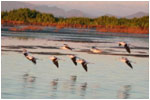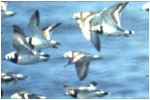| |
|
What are Shorebirds? 
The Shore
Land and water -- they are the two most basic geographic features of the earth's surface. What happens along the narrow lines where these two great bodies meet? This fragile strip contains some of the greatest diversity (variety of living organisms) on our planet. It is enriched by life-sustaining water, yet must also endure some very powerful natural forces. It is called the shore, and it is land that:
- faces regular and irregular periods of drying out, dampness, or flooding;
- contains a tremendously fluctuating range of salinity; and
- is eroded by wind and water.
Shorebirds
 Organisms that live in this precious environment have adapted to thrive in these conditions. Shorebirds are a group of special birds that are adapted to live near these coasts, or shores. Because of their lifestyle, particularly during their spectacular migrations, of walking through water and mud to find food, Europeans call these long legged birds "waders."
Organisms that live in this precious environment have adapted to thrive in these conditions. Shorebirds are a group of special birds that are adapted to live near these coasts, or shores. Because of their lifestyle, particularly during their spectacular migrations, of walking through water and mud to find food, Europeans call these long legged birds "waders."
Each spring and fall, enormous flocks of shorebirds swarm along the coasts in great migrations. It is a thrilling sight when the shore comes alive with feeding birds, or a flock swiftly wheels and turns in flight. These flocks pulse to and fro with the cycles of the tides, and, on a broader scale, with the cycles of the seasons. Shorebirds eat, breed, travel, and rest as a part of these cycles of nature.
Shorebirds are more accurately described as birds of open land, including, but not limited to, the shore. Shorebirds include the sandpipers, plovers, oystercatchers, snipes, and stilts, among others.
 Besides their regular migrations, their lifestyle includes other highly developed rituals of behavior, including elaborate courtship displays. Most of us have never had the pleasure of witnessing these displays, because many migratory shorebirds nest in remote Arctic tundra or open grassland.
Besides their regular migrations, their lifestyle includes other highly developed rituals of behavior, including elaborate courtship displays. Most of us have never had the pleasure of witnessing these displays, because many migratory shorebirds nest in remote Arctic tundra or open grassland.
There are about 214 species of shorebirds in the world. Almost 80 of these regularly occur in North America. Seventy-five species breed in the Holarctic region. This means they summer in either the North American Arctic (Nearctic) or Northern Europe and Russia (Palearctic). Many species of these great migrators breed in both of these areas. See if you can tell why this might be so by looking at a globe.
Photo Gallery
  |
|
|
|
